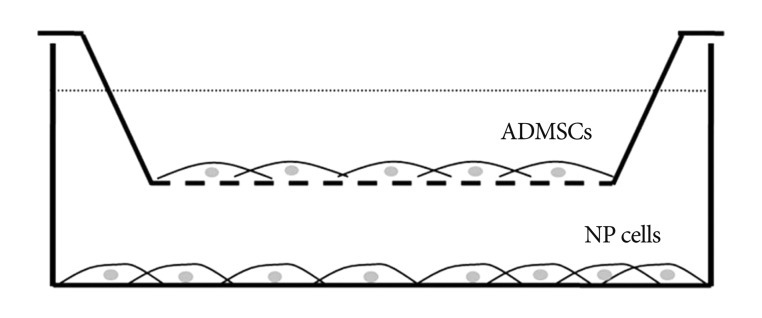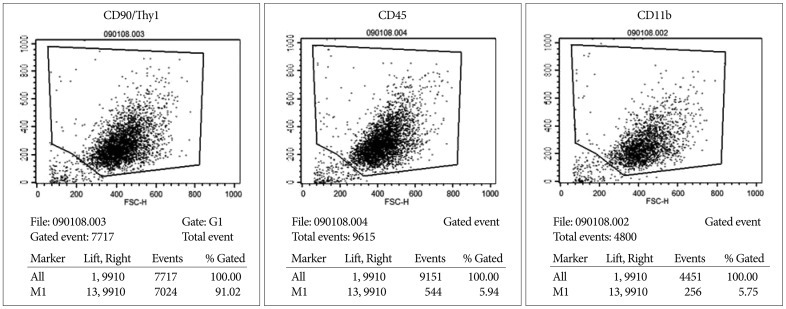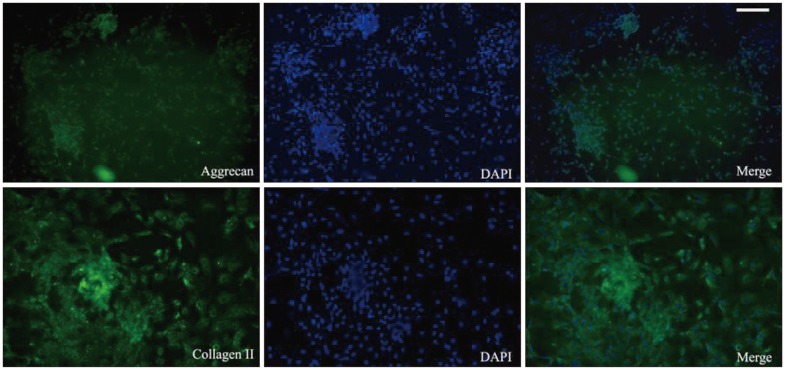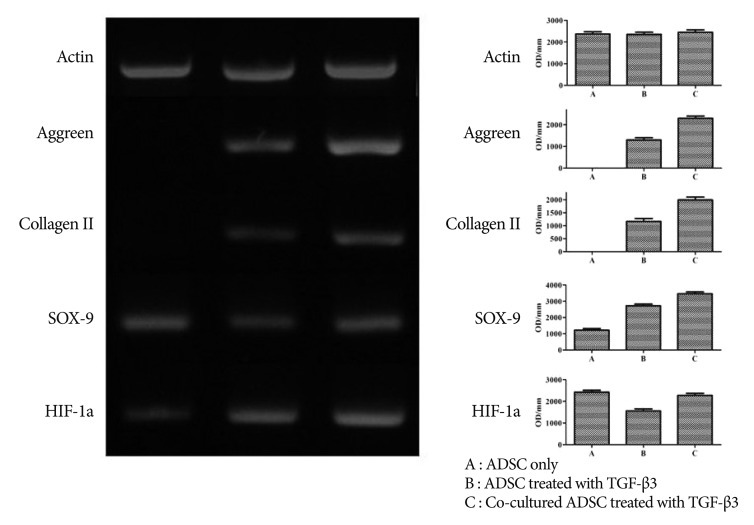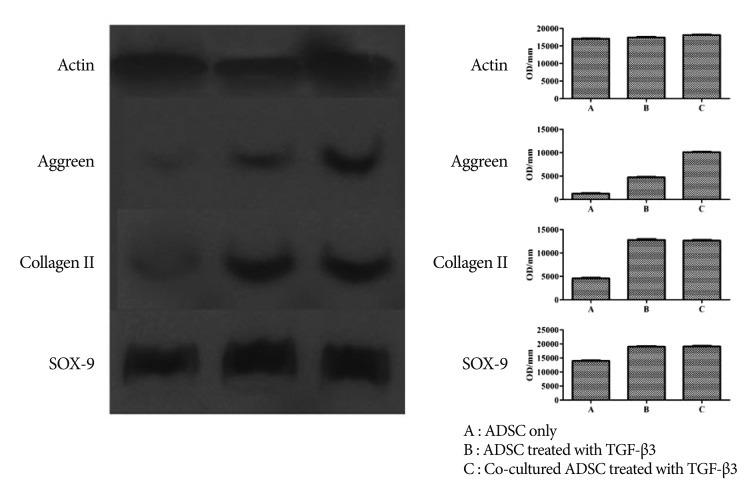J Korean Neurosurg Soc.
2013 Apr;53(4):207-212. 10.3340/jkns.2013.53.4.207.
Analysis of Molecular Expression in Adipose Tissue-Derived Mesenchymal Stem Cells : Prospects for Use in the Treatment of Intervertebral Disc Degeneration
- Affiliations
-
- 1Laboratory of Stem Cell Therapy, Asan Medical Center, College of Medicine, University of Ulsan, Seoul, Korea. neuri71@gmail.com
- 2Department of Internal Medicine, College of Medicine, Kyung Hee University, Seoul, Korea.
- 3Department of Neurosurgery, Asan Medical Center, College of Medicine, University of Ulsan, Seoul, Korea.
- 4Department of Rehabilitation Medicine, Asan Medical Center, College of Medicine, University of Ulsan, Seoul, Korea.
- 5Department of Neurological Surgery, Soonchunhyang University Bucheon Hospital, Bucheon, Korea.
- KMID: 1426205
- DOI: http://doi.org/10.3340/jkns.2013.53.4.207
Abstract
OBJECTIVE
Recent studies have shown encouraging progress toward the use of autogenic and allogenic mesenchymal stem cells (MSCs) to arrest, or even lead to partial regeneration in, intervertebral disc (IVD) degeneration. However, this technology is still in its infancy, and further development is required. The aim of this study was to analyze whether rat adipose-derived mesenchymal stem cells (ADMSC) can differentiate towards IVD-like cells after treatment with transforming growth factor beta3 (TGF-beta3) in vitro. We also performed quantitative analysis of gene expression for ADMSC only, ADMSCs treated with TGF-beta3, and co-cultured ADMSCs treated with TGF-beta3.
METHODS
ADMSCs were sub-cultured to homogeneity and used in fluorocytometry assays for CD11, CD45, and CD90/Thy1. ADMSCs were differentiated in spheroid culture towards the chondrogenic lineage by the presence of TGF-beta3, dexamethasone, and ascorbate. We also co-cultured pure ADMSCs and nucleus pulposus cells in 24-well plates, and performed immunohistochemical staining, western blotting, and RT-PCR for quantitativeanalysis of gene expression.
RESULTS
Results of fluorocytometry were positive for CD90/Thy1 and negative for CD11 and CD45. TGF-beta3-mediated induction of ADMSCs led to the expression of the differentiation markers of intervertebral disc-like cells, such as aggrecan, collagen II, and sox-9. Co-cultured ADMSCs treated with TGF-beta3 showed higher expression of differentiation markers and greater extracellular matrix production compared with ADMSCs treated with TGF-beta3 alone.
CONCLUSION
ADMSC treated with TGF-beta3 may be an attractive source for regeneration therapy in degenerative IVD. These findings may also help elucidate the pathologic mechanism of MSC therapy in the degeneration of IVD in vivo.
MeSH Terms
-
Adipose Tissue
Aggrecans
Animals
Antigens, Differentiation
Blotting, Western
Collagen
Dexamethasone
Extracellular Matrix
Gene Expression
Intervertebral Disc
Intervertebral Disc Degeneration
Mesenchymal Stromal Cells
Rats
Regeneration
Transforming Growth Factor beta3
Aggrecans
Antigens, Differentiation
Collagen
Dexamethasone
Transforming Growth Factor beta3
Figure
Reference
-
1. Hunter CJ, Matyas JR, Duncan NA. The notochordal cell in the nucleus pulposus : a review in the context of tissue engineering. Tissue Eng. 2003; 9:667–677. PMID: 13678445.
Article2. Izadpanah R, Trygg C, Patel B, Kriedt C, Dufour J, Gimble JM, et al. Biologic properties of mesenchymal stem cells derived from bone marrow and adipose tissue. J Cell Biochem. 2006; 99:1285–1297. PMID: 16795045.
Article3. Kern S, Eichler H, Stoeve J, Klüter H, Bieback K. Comparative analysis of mesenchymal stem cells from bone marrow, umbilical cord blood, or adipose tissue. Stem Cells. 2006; 24:1294–1301. PMID: 16410387.
Article4. Le Visage C, Kim SW, Tateno K, Sieber AN, Kostuik JP, Leong KW. Interaction of human mesenchymal stem cells with disc cells : changes in extracellular matrix biosynthesis. Spine (Phila Pa 1976). 2006; 31:2036–2042. PMID: 16915085.5. Leung VY, Chan D, Cheung KM. Regeneration of intervertebral disc by mesenchymal stem cells : potentials, limitations, and future direction. Eur Spine J. 2006; 15(Suppl 3):S406–S413. PMID: 16845553.6. Li X, Lee JP, Balian G, Greg Anderson D. Modulation of chondrocytic properties of fat-derived mesenchymal cells in co-cultures with nucleus pulposus. Connect Tissue Res. 2005; 46:75–82. PMID: 16019417.
Article7. Richardson RM, Barbaro NM, Alvarez-Buylla A, Baraban SC. Developing cell transplantation for temporal lobe epilepsy. Neurosurg Focus. 2008; 24:E17. PMID: 18341393.
Article8. Richardson SM, Curran JM, Chen R, Vaughan-Thomas A, Hunt JA, Freemont AJ, et al. The differentiation of bone marrow mesenchymal stem cells into chondrocyte-like cells on poly-L-lactic acid (PLLA) scaffolds. Biomaterials. 2006; 27:4069–4078. PMID: 16569429.
Article9. Sakai D, Mochida J, Yamamoto Y, Nomura T, Okuma M, Nishimura K, et al. Transplantation of mesenchymal stem cells embedded in Atelocollagen gel to the intervertebral disc : a potential therapeutic model for disc degeneration. Biomaterials. 2003; 24:3531–3541. PMID: 12809782.
Article
- Full Text Links
- Actions
-
Cited
- CITED
-
- Close
- Share
- Similar articles
-
- Transplantation of adipose derived mesenchymal stem cells for acute thoracolumbar disc disease with no deep pain perception in dogs
- The Effects of Human Adipose Tissue Derived Mesenchymal Stem Cells on Degenerative Change of Disc in Rabbit Model
- Effect of Conditioned Medium from Human Umbilical Cord-Derived Mesenchymal Stromal Cells on Rejuvenation of Nucleus Pulposus Derived Stem/Progenitor Cells from Degenerated Intervertebral Disc
- Concise Review: Differentiation of Human Adult Stem Cells Into Hepatocyte-like Cells In vitro
- Biochemical Factors of Intervertebral Disc Degeneration: Implications for Disc Regeneration

